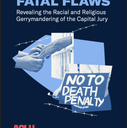
Most of the 142 prisoners on North Carolina’s death row were convicted under obsolete and outdated death-penalty laws and would not have been sentenced to death if tried today, according to a new report by the Center for Death Penalty Litigation. The report by the Durham-based defense organization, titled Unequal Justice: How Obsolete Laws and Unfair Trials Created North Carolina’s Outsized Death Row, says that nearly three-quarters of the prisoners on the nation’s sixth-largest death row were tried and sentenced before the state enacted significant reforms in prosecution, defense, and trial practices. “[I]f these people on death row had been tried under modern laws, most of them would be serving life without parole sentences instead of facing execution,” said Gretchen Engel, the Center’s executive director.
Seventy-three percent of the men and women on North Carolina’s death row (103 prisoners) were tried and sentenced to death before July 2001, when North Carolina repealed a 1990s-era law that had required prosecutors to pursue the death penalty in every aggravated murder case, irrespective of reasons that might call for mercy, and created a statewide office to represent indigent defendants in capital trials and appeals. North Carolina was the only state in the country that denied prosecutors the discretion to decide when to seek the death penalty, and as a result, there were more than fifty capital trials in the state each year, including cases involving defendants who were seriously mentally ill or intellectually disabled or were comparatively minor participants in a murder. Capital trials fell to an average of sixteen per year in the decade following the change. The creation of the capital defender office that same year dramatically improved the quality of representation, and further reduced the number of cases in which death verdicts were returned. Since then, North Carolina has enacted additional reforms aimed at ensuring fairer trials in capital cases. In October 2004, the state became the first in the country to require prosecutors to make all witness files, police reports, other investigative records, and physical evidence available to capital defendants prior to trial. In 2008, it adopted a series of eyewitness identification and interrogation protocols designed to prevent mistaken identifications and false or coerced confessions.
The report states that during the 1990s, before the reforms were enacted, “courtrooms were dominated by prosecutors like Ken Honeycutt in Stanly County, who celebrated new death sentences by handing out noose lapel pins to his assistant prosecutors.” “Today,” Engel said, “we are living in a different world .… Public support for the death penalty is at a 50-year low, and North Carolina has stopped executing people. Juries now see life without parole as a harsh and adequate punishment for the worst crimes.” That, however, has produced its own historical inequities. In terms of moral culpability, Engel said, the defendants facing trial in 1995 and 2015 “are equal. And yet, one of them is being subjected to execution and other is not and that is an unfairness that as a fair society, we can not tolerate.”
(The Center for Death Penalty Litigation, How Obsolete Laws and Unfair Trials Created North Carolina’s Outsized Death Row, September 2018; Rebecca Martinez, ‘The Rat in the Snake’s Belly’: Most Death Row Inmates In NC Await an Uncertain Fate, WUNC, North Carolina Public Radio, October 12, 2018; Michael Gordon, Most people on NC death row don’t belong there, new report says. Here’s why., Charlotte Observer, October 12, 2018.) See North Carolina, Arbitrariness, and Sentencing.



